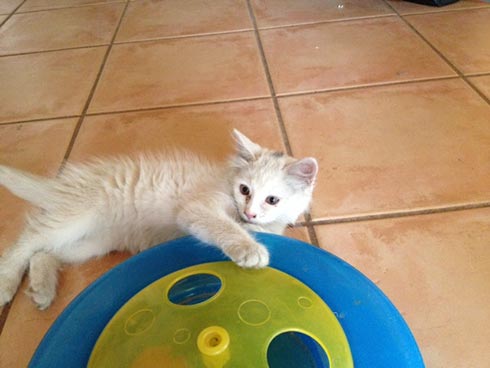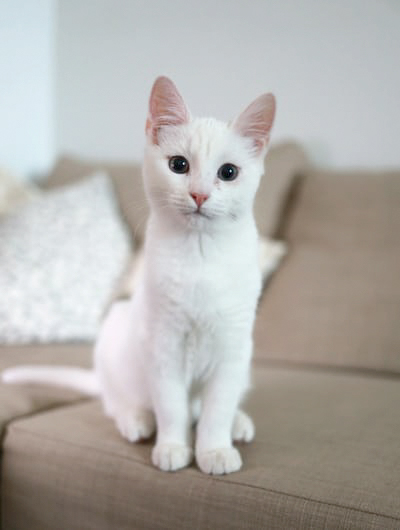Mr. L – Somebody got Lucky
I was wearily motoring home, down unlit El Pueblo Road, when my Triumph’s headlights lit up a slow moving small while object. Grocery bag in the breeze? Ah, no. White kitten on 3 legs. The day wasn’t over yet.
Cats are predators for sure, but they are also a prey species. When sick or injured the wild ones tend to hole-up to avoid being coyote bait, making them impossible to catch. I made a U-turn and rolled to a stop on the gravel shoulder. As I approached the little guy he blinked slowly at me and then limped in my direction.
Martha and Amos, my two staff members, had left for the day. I threw the deadbolt, switched on the light, and carried my 6# runaway to the treatment table. He actually looked good on exam – except for that right femur fracture. I’d need some help to get x-rays.
To be sure he was well hydrated I administered warm fluids under his skin and then snuggled him in to our warm water circulating blanket. Between ravenous mouthfuls of canned food my patient purred peacefully. I took a liking to the kid; he was down-right cooperative and sweet.
I wasn’t looking to expand my pet family; I already had Bob and Polly, my own dog and cat. (What kind of person gives human names to animals? Mine have all had namesakes, the Nichol family puppy, Mick Jagger, being no exception.) Besides, this was not my cat.
The next morning, Martha and Amos beat me to work and, well, they were just tickled about the new kitten. I hastily explained that he was not ours. Surely we would find his family. We anesthetized the little devil, found the location of his transverse fracture on x-rays, prepped the leg, and took him to surgery. Intramedullary pins, stacked in place, showed good alignment on post-op films. His eyes popped open 20 minutes later.
On my way home from work, doing my best not to look like a Fuller Brush salesman, I knocked on doors.
A Cat & a Gentleman
My practice was in its infancy in 1978 but we were ready for anything. I had an ECG, x-ray machine, and a full array of surgical instruments – everything but stationery and business cards. The equine veterinarian next door recommended a printer, so I called Mr. Franklin Lancaster. He offered to come by to design my spiffy new letterhead.
When this senior gentleman arrived he cordially greeted Martha at the front desk and waited patiently as I finished with a client who had brought in an chicken with diarrhea. That’s right – a chicken named Harley (not Nugget) who recovered just fine, thank you very much. I washed my hands of feathers and poultry droppings and invited Mr. Lancaster into my slightly-bigger-than-a-phonebooth-sized office. Despite being old enough to be my grandfather he treated me with deference. I was struck by his courtly manners. Examples of good behavior can appear any time.
I placed my order and walked Mr. Lancaster to the door. As I turned around I glanced over at Martha behind the counter to find a young woman just bursting with unbridled enthusiasm. She summarily announced the name of our new cat: Mr. Lancaster. Did I mention my tendency to name pets after people? Well, I am not alone.
My initial admonishment to Martha and Amos that this was not our kitten, and most certainly was someone else’s errant pet, had lost all credibility. It was only the previous evening that I had scoured El Pueblo Road for the blue-eye white kitty’s family and, finding no one willing to acknowledge pet parenthood, I admitted that we now had a clinic cat. As we came to know our new pet it became clear that if anybody needed an example of good behavior it was Mr. Lancaster – the feline version, that is.
Are Predators Gentlemen?
Young Mr. Lancaster was a kitten whose behavior was sometimes, as they say in learning theory, undesirable. He did turn out to be a pretty good cat, hanging out at the reception desk, accepting attention from our clients. On the flip side, even at the tender age of 6 months he was a wild animal masquerading as a cuddly pet.
We love our kitties like little people in furry suits but they are stalkers, slayers, and devourers of helpless creatures. By that feline standard, even in our compassionate veterinary clinic, there had to be somebody who needed killing and eating.
One fine summer day a couple arrived with a Pekin white duckling with a fractured leg. In their futile attempts to avoid veterinary bills they had fashioned a homemade splint that failed miserably. The little guy’s mother and siblings, crowded in a muddy pen, had stepped on him, sat on him, and pushed him away from the food. He arrived dehydrated, weak, and dragging a badly infected leg.
Could we help? Well, we could try but I explained that the outlook wasn’t good. We cleaned the wounds, tubed food and water into the little quacker’s 4 ounce body, and kept him warm. Martha took on the nursing responsibility at the front desk. An hour later, responding to our call for assistance in the treatment room, she left her fuzzy patient in an open-topped box.
As she returned to her station just a few minutes later Martha spied our resident predator, his head and shoulders thrust into the box. Racing to pluck the duck from the jaws of Mr. L she yelled (loudly), “Mr. Lancaster!,” startling the little brute just before he could take a nip. That’s when a voice on the other side of the reception counter hastily sputtered apologies for being a day late in delivering our stationery. You guessed it. The real Mr. Lancaster was standing on the other side of the desk, waiting for Martha’s return.
Poor Martha was suddenly in the awkward position of explaining that, no, we were not mad at Mr. Lancaster the printer but yes, he was the namesake of our murderous kitten.
Assassin on the Job
Mr. Lancaster Sr. was tall, lean, and spry, I’d guess about 80 years old. He was a quiet, likable man who typeset and printed our medical forms. Friendly chit chat revealed that he lived quietly with his daughter.
There weren’t many veterinarians in Albuquerque in the late ’70s; everybody knew everybody. Of course, that made gossip a hot commodity. When Dr. Mike Adams encountered me at a continuing education conference he could hardly contain his excitement. Clearly feeling the power of knowledge he dropped the bomb that Mr. Lancaster was a convicted counterfeiter who’d been released from federal prison only 3 years earlier.
The old timer’s history did not diminish our esteem for him. He’d gotten himself on the wrong side of the law and he’d paid the price. Mr. Lancaster Jr. – our new cat –, on the other hand, was a horse of a different color. Still a kid, he was a budding murderer of helpless creatures, normal for his species.
In its early years my practice lived in a rented space, sandwiched between an equine veterinary clinic and a feed retailer. Grain was stored on each side. The open field out back served as a breeding ground for field mice. That environment plus the fine dining experience offered by my neighbors provided us with an endless supply of rodents.
Mice are born, they reproduce, and then they die. Ashes to ashes, just like everybody else on the planet. It was their cadavers, moldering in the warm space above our suspended ceiling, that put a damper on the otherwise sweet ambiance of my space. We had a problem and young Mr. L needed gainful employment that did not involve predation on one-legged peepers. Problem or opportunity?
It was Martha’s acute powers of olfaction that drove her to surreptitiously invite our fuzzy white pet into the storage room behind the equine clinic. At the end of his first day, his job satisfaction was evidenced by his ample girth. Young Mr. Lancaster happily scampered off to work each morning, reducing our cat food expenses.
Crime Buster? Not
Acute hearing is among most cat’s best methods of detecting movement of nearby prey but not for fuzzy Mr. Lancaster. Like the majority of blue-eyed white kitties, he was genetically as deaf as a post. Despite this handicap he was an inspiration to all of us. We could have changed his name to “Mouse B. Gone.” Sadly, he was less adept at collaring thieves.
After 3 years as an associate veterinarian I realized a life goal of owning my own practice. I’d saved and invested heavily; providing good medicine requires serious equipment purchases. I was an intense young man. Now, I am no less intense but I am less young. Slow days were difficult in those early months.
Mr. Lancaster was the only creature stirring when I arrived at the clinic one morning, but he had not spent the night alone. The front door had been forced open. Instruments and cash (not much of that) was stolen. I felt like I was clawing my way through a mud pit as I made a police report, filed an insurance claim, and cleaned up the mess.
Martha, Amos, and I were feeling sad and, frankly a bit agitated but Mr. L was noticeably sanguine. His total silence, when Martha pointedly asked him to identify the perpetrator(s), was no surprise to me. Every day I wish pets would speak a human language but they insist on communicating as who they are – cats and dogs.
Amos, on the other hand, deduced that Mr. Lancaster’s slow blinking meant that he knew the intruder. This well-intentioned young man wasn’t the first person to believe he could divine the secrets of animal communication but it was not to be. Nobody’s initials were found scratched in the cat litter.
Current understanding of animal behavior relies on peer-reviewed published research. We now know that our cat’s slow blinking simply indicated an affiliative emotional state. Mr. L didn’t care that we’d been ripped-off; he just wanted Amos to pet him.
All was not lost. The one legged duckling our predator-in-residence nearly lunched became a pet for one of our excellent clients. The burglar’s identity, however, remains shrouded in mystery. I wish him or her no misfortune, except maybe a decomposing mouse above their ceiling.







